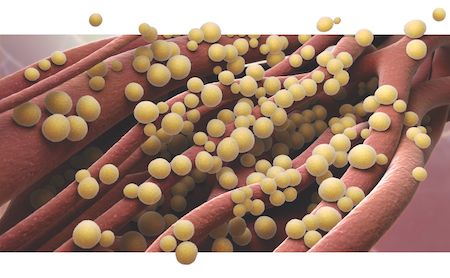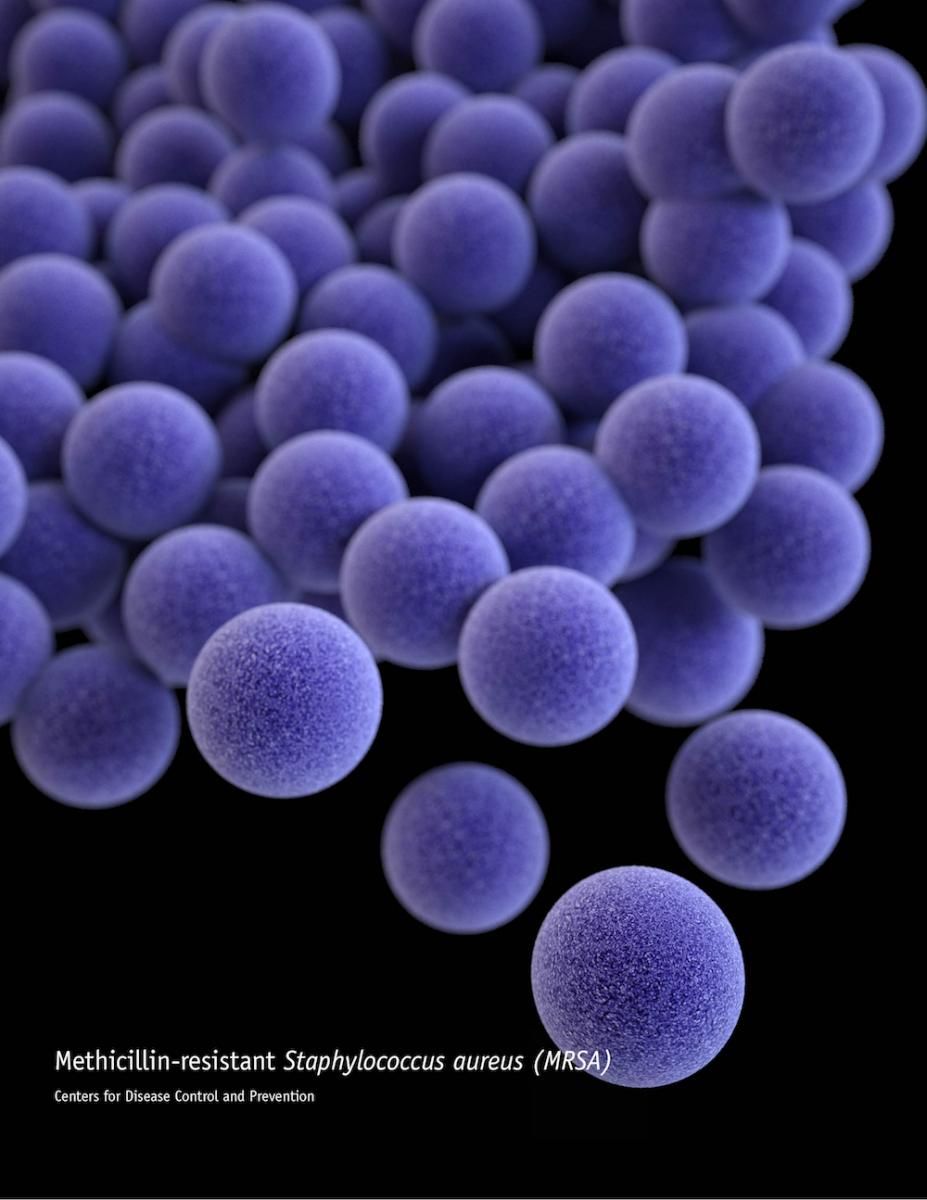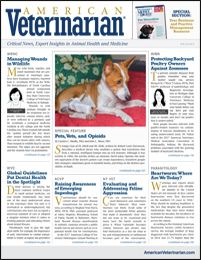ACVP 2018: Raising Awareness of Emerging Superbugs
Bacterial strains that have become resistant to antibiotics—particularly gram-positive organisms such as Staphylococcus—pose a growing threat to both people and animals.

All Staphylococcus species that infect humans and domestic animals exhibit some degree of antimicrobial resistance.
Veterinarians should be concerned about zoonotic disease transmission for several reasons, according to Meghan Frost Davis, MPH, DVM, PhD, assistant professor at Johns Hopkins Bloomberg School of Public Health in Baltimore, Maryland. Beyond disease manifestation in animals, zoonoses present a public health risk for pet owners and an occupational health risk for veterinarians.
At the 2017 American College of Veterinary Pathologists Annual Meeting in Vancouver, British Columbia, Canada, Dr. Davis discussed the risks posed by the emergence of antibiotic resistance in some bacteria, focusing on staphylococci.
Gram-positive bacteria such as staphylococci are typically more environmentally hardy than gram-negative organisms are, she said, because gram-positive bacteria have a relatively thick cell wall made up of multiple layers of peptidoglycan. The thinner cell wall of gram-negative bacteria comprises fewer layers of peptidoglycan, although these organisms also have an outer membrane containing lipopolysaccharide.
RELATED:
- What's in Your Practice? S aureus and MRSA in a Veterinary Academic Community
- Carprofen Potentiates Activity of Doxycycline Against Methicillin-Resistant Staphylococcus pseudintermedius In Vitro
Because gram-positive bacteria tend to persist longer in the environment, they pose a concern from a One Health perspective, Dr. Davis said. Multiple factors affect environmental longevity. In general, staphylococci can survive on surfaces for weeks to months, and Dr. Davis stressed that “at least weeks” is a good rule of thumb.
These organisms do not simply transmit from person to person, she noted. They also can move around on dust particles—even making the bed has been associated with airborne re-suspension of Staphylococcus aureus. Because dust that goes up eventually comes down, surfaces that typically go untouched, including upper surfaces in veterinary hospitals and necropsy rooms, can become contaminated. The bacteria also may persist on dry fomites, such as keyboards and cell phones, and be transmitted through contact with these surfaces.
Antimicrobial Resistance in Staphyloccus Species
Methicillin-susceptible S aureus strains become methicillin-resistant S aureus (MRSA) strains by acquiring a staphylococcal cassette chromosome mec (SCCmec) element carrying the mecA gene, which is responsible for methicillin resistance, Dr. Davis said.
Currently, all Staphylococcus species that infect humans and domestic animals exhibit some degree of antimicrobial resistance. Over the past decade, methicillin resistance has become a serious and increasing problem in both veterinary and human medicine.
Important Methicillin-Resistant Staphylococcus Species in Veterinary Medicine

-resistant Staphylococcus schleiferi (MRSS) and Staphylococcus lugdunensis, also have become increasingly problematic in veterinary medicine.
The prevalence rates of these methicillin-resistant strains may vary according to animal species, she said. For example, S pseudintermedius occurs more in dogs than cats. In cats, however, all 3 organisms tend to have similar prevalence rates.
MRSA
Although S aureus is primarily a pathogen of people, it can colonize and infect animals. In human medicine, skin and soft tissue infections due to MRSA have caused significant public health and economic burdens for several decades, especially in relation to hospital-associated infections. However, MRSA also poses a risk to companion animals, Dr. Davis said.
Most cases of MRSA in dogs and cats tend to result from exposure of animals to infections in their owners, Dr. Davis said. She discussed the Pets and Environmental Transmission of Staphylococci (PETS) study, in which her research team analyzed swabs collected from 196 pets that lived with a MRSA-infected person.2 “Despite being exposed to a pet owner with a MRSA infection, dogs were still more likely to be carriers of S pseudintermedius [20% vs 41%],” she said, noting that this highlights the species adaptation of S pseudintermedius to dogs. In comparison, 17% of cats were carriers of MRSA, she said, and just 3% of S pseudintermedius.
Veterinarians do not necessarily have to determine whether an animal living with an infected owner also has MRSA, Dr. Davis said. Instead, she recommends that veterinarians consider both routine contact isolation of the animal and environmental decontamination while the owner is being treated. “A key message is ‘remember the environment,’” she said.
Nevertheless, sometimes a veterinarian might need to determine whether an animal is a reservoir of MRSA, such as in cases involving intractable infections in the owner’s family or for research purposes. In these instances, veterinarians should collect swabs from the animal’s mouth, which the PETS study findings showed to be the most sensitive anatomic site to sample for isolation of staphylococci in this kind of population, Dr. Davis said. The site may differ for animals not exposed to an owner with MRSA infection. Genetic testing has shown that companion animals such as dogs and cats typically carry MRSA strains associated with humans, such as MRSA clonal complex (CC) 8. In contrast, large animal species tend to carry animal-adapted strains, such as CC398 and CC9 in livestock. Interestingly, many of the livestock-adapted strains do not carry the staphylococcal complement inhibitor (scn) gene, an immune evasion cluster gene that encodes an immune-modulating protein.
Two main lineages of livestock-associated MRSA exist, Dr. Davis said. One, CC398, associated with tetracycline resistance, typically is transmitted from animal to animal and has become a rapidly emerging cause of human infections, usually through livestock exposure. The other, CC9, is an emerging strain first identified in Asia in association with pigs and pork products.
MRSP
Dr. Davis described MRSP as the kissing cousin of MRSA and a major concern in veterinary medicine. This leading cause of dermatologic disease in dogs is becoming increasingly multidrug resistant, she said, with the potential to infect humans, especially people with dog bite wounds. Dr. Davis reported carriage rates of up to 12% for owners in contact with MRSP-infected dogs.
Coagulase-Negative Staphylococci
Although MRSA and MRSP are coagulase-positive staphylococci, coagulase-negative staphylococci are also emerging as significant pathogens in veterinary practice, according to Dr. Davis.
S schleiferi is one such emerging pathogen in both pets and people, with some evidence for increasing drug resistance. It was originally characterized as 2 subspecies: 1 coagulase-negative and 1 coagulase-positive. However, recent genome sequencing studies have shown that these are not different subspecies but, rather, simply variants within 1 particular species. S schleif- eri species are considered “coagulase variable,” she said.
S lugdunensis is another coagulase-negative organism and emerging pathogen in pets and people. It typically causes skin infections or endocarditis in people. “So, don’t assume that just because a Staphylococcus strain is coagulase negative that it is not the cause of infection,” Dr. Davis emphasized.
Identifying Methicillin-Resistant Staphylococci
Culture is the gold standard laboratory method used to detect staphylococci, Dr. Davis said. However, she noted, it typically uses a broth-based enrichment technique to address contamination with nontarget bacteria and favor staphylococcal growth. In addition, because the epidemiology, pathogenicity, and drug resistance of these bacteria vary depending on their species, it is important to speciate any staphylococcal isolates identified in a clinical specimen.
Strain typing provides additional useful information, she said, and is important for diagnosis, treatment, and epidemiologic surveillance of these bacterial infections. Several molecular typing methods are used to characterize these bacteria, although there is no consensus regarding the single best method.
Pulsed-field gel electrophoresis has traditionally been considered the gold standard for molecular strain typing, particularly because of its high discriminatory power and standardized protocols. Its downside: Results may differ from one laboratory to another.
Other methods, such as multilocus sequence typing and staphylococcal protein A typing, are also widely used for distinguishing genetic relationships between groups of methicillin-resistant staphylococcal strains. Whole-genome sequencing, a relatively new technique that uses next-generation DNA technology to compare the genomes of bacterial isolates, is rapidly becoming the new gold standard typing method, Dr. Davis said, although it typically costs more than other typing methods. Prices have been dropping as the technology improves, she added.
Occupational Exposure to MRSA
To illustrate the occupational health risks of MRSA, Dr. Davis discussed a study that investigated MRSA carriage in people who worked on pig farms.3 The findings showed that workers who always wore masks when working with the animals had the lowest rates of nasal colonization with livestock-associated drug-resistant MRSA strains. Those who wore masks only occasionally saw no benefit.
Emergence of MRSA, especially ST188 isolates, also has been reported in nonhuman primate collections, Dr. Davis said, highlighting captive nonhuman primates as an underrecognized source of MRSA.4-6 She described a recent report of a severe MRSA skin infection in an animal technician who had been bitten by a MRSA-colonized primate.4
Because methicillin-resistant staphylococci are relatively common pathogens in animals, Dr. Davis reminded veterinarians to be aware of the associated public health and occupational health risks. The exposures of pig farm workers and the technician to MRSA underscore the need to use personal protective equipment when working with potentially colonized animals or infected tissues, she said: “Both pathologists and clinicians could be at risk for exposure.”
Dr. Parry, a board-certified veterinary pathologist, graduated from the University of Liverpool in 1997. After 13 years in academia, she founded Midwest Veterinary Pathology, LLC, where she now works as a private consultant. Dr. Parry writes regularly for veterinary organizations and publications.
References:
- Morris DO, Loeffler A, Davis MF, Guardabassi L, Weese JS. Recommendations for approaches to meticillin-resistant staphylococcal infections of small animals: diagnosis, therapeutic considerations and preventative measures. Vet Dermatol. 2017;28(3):304-e69. doi: 10.1111/vde.12444.
- Iverson SA, Brazil AM, Ferguson JM, et al. Anatomical patterns of colonization of pets with staphylococcal species in homes of people with methicillin-resistant Staphylococcus aureus (MRSA) skin or soft tissue infection (SSTI). Vet Microbiol. 2015;176(1-2):202-208. doi: 10.1016/j.vetmic.2015.01.003.
- Ven Cleef BAGL, van Benthem BHB, Verkade EJM, et al. Livestock-Associated MRSA in Household Members of Pig Farmers: Transmission and Dynamics of Carriage, A Prospective Cohort Study. PLOS One. 2015;10(5):e0127190. doi: 10.1371/journal.pone.0127190.
- Soge OO, No D, Michael KE et al. Transmission of MDR MRSA between primates, their environment and personnel at a United States primate centre. J Antimibrob Chemother. 2016;71(10):2798-2803. doi: 10.1093/jac/dkw236.
- Schaumburg F, Mugisha L, Kappeller P, et al. Evaluation of non-invasive biological samples to monitor Staphylococcus aureus colonization in great apes and lemurs. PLOS One. 2013;8(10):e78046. doi: 10.1371/journal.pone.0078046.
- Methicillin-resistant Staphylococcus non-aureus Infection in an Irradiated Rhesus Macaque (Macaca mulatta). J Am Assoc Lab Anim Soc. 2008;47(3):64-67.
